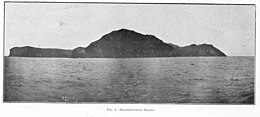Disappointment Island
 A photo taken of the island in 1909. | |
 Position of the Auckland Islands relative to New Zealand and other outlying islands | |
| Geography | |
|---|---|
| Coordinates | 50°36.25′S 165°58.38′E / 50.60417°S 165.97300°E |
| Archipelago | Auckland Islands |
| Area | 3.0 km2 (1.2 sq mi) |
| Length | 3.35 km (2.082 mi) |
| Width | 1.53 km (0.951 mi) |
| Demographics | |
| Pop. density | 0/km2 (0/sq mi) |
Disappointment Island is one of seven uninhabited islands in the Auckland Islands archipelago, in New Zealand. It is 475 kilometres (295 mi) south of the country's main South Island and 8 kilometres (5 mi) from the northwest end of Auckland Island. It is home to a large colony of white-capped albatrosses: about 65,000 pairs – nearly the entire world's population – nest there.[1] Also on the island is the Auckland rail, endemic to the archipelago; once thought to be extinct, it was rediscovered in 1966.[2]
History
On 7 March 1907, the Dundonald, a steel, four-masted barque, sank after running ashore on the west side of Disappointment Island. Twelve men drowned and seventeen men made it ashore.[3] Two of the men died, and fifteen survivors waited seven months for rescue.[4] They survived by eating mainly white-capped albatrosses (mollymawks), seals, and roots of the plant Azorella polaris, and, later, supplies at the castaway depot on Auckland Island.[3] The island was visited by a scientific expedition aboard the Hinemoa in November 1907, after the crew rescued the Dundonald survivors from Auckland Island.[5][3]
Etymology
British mariner Abraham Bristow, who was the first European to reach the Auckland Islands, named the island Disappointment Island.[6][7] Whilst aboard the ship Sarah in 1807, he unsuccessfully surveyed the island for fur seals and a base to reach the nearby fur seal rookeries on the western cliffs of Auckland Island.[6][7]
Important Bird Area
The island is part of the Auckland Island group Important Bird Area (IBA), identified as such by BirdLife International because of the significance of the group as a breeding site for several species of seabirds, including the white-capped mollymawk and white-chinned petrel, as well as the endemic Auckland shag, Auckland teal, Auckland rail, and Auckland snipe.[8][9]
See also
- Composite Antarctic Gazetteer
- Scientific Committee on Antarctic Research
- New Zealand subantarctic islands
- List of Antarctic and subantarctic islands
- List of islands of New Zealand
- List of islands
- Desert island
References
- ^ BBC – Science and Nature Archived 5 December 2004 at the Wayback Machine.
- ^ Auckland Islands Rail.
- ^ a b c Escott-Inman, Herbert (1911). The Castaways of Disappointment Island. S.W. Partridge & Co.
- ^ Wrecked on the Auckland Islands in 1907.
- ^ Cockayne, L. (3 December 1907), "Disappointment Island. A new field. The first scientific visitors. Animals and plants on the island.", The Lyttelton Times, retrieved 20 August 2020
- ^ a b Walker, Kath; Elliott, Graeme; Rexer-Huber, Kalinka; Parker, Graham; Sagar, Paul; McClelland, Peter J. (2020). "Shipwrecks and mollymawks: an account of Disappointment Island birds". Notornis. 67 (1): 213–245.
- ^ a b Jones, K. K.; Dingwall, P. R. (1 January 2009). "Historic landscapes and seascapes of the Auckland Islands". New Zealand Archaeological Association Monograph. 27: 245–267.
- ^ BirdLife International. (2012). Important Bird Areas factsheet: Auckland Islands. Downloaded from "BirdLife International - conserving the world's birds". Archived from the original on 10 July 2007. Retrieved 16 December 2012. on 2012-01-23.
- ^ Walker, Kath; Elliott, Graeme; Rexer-Huber, Kalinka; Parker, Graham; Sagar, Paul; McClelland, Peter J. (1 January 2020). "Shipwrecks and mollymawks: an account of Disappointment Island birds". Notornis. 67 (1): 213–245.
- Webarchive template wayback links
- Articles with short description
- Short description matches Wikidata
- Use dmy dates from December 2020
- Use New Zealand English from March 2024
- All Wikipedia articles written in New Zealand English
- Coordinates on Wikidata
- Islands of the Auckland Islands
- Important Bird Areas of the Auckland Islands
- Uninhabited islands of New Zealand
- All stub articles
- New Zealand outlying island geography stubs